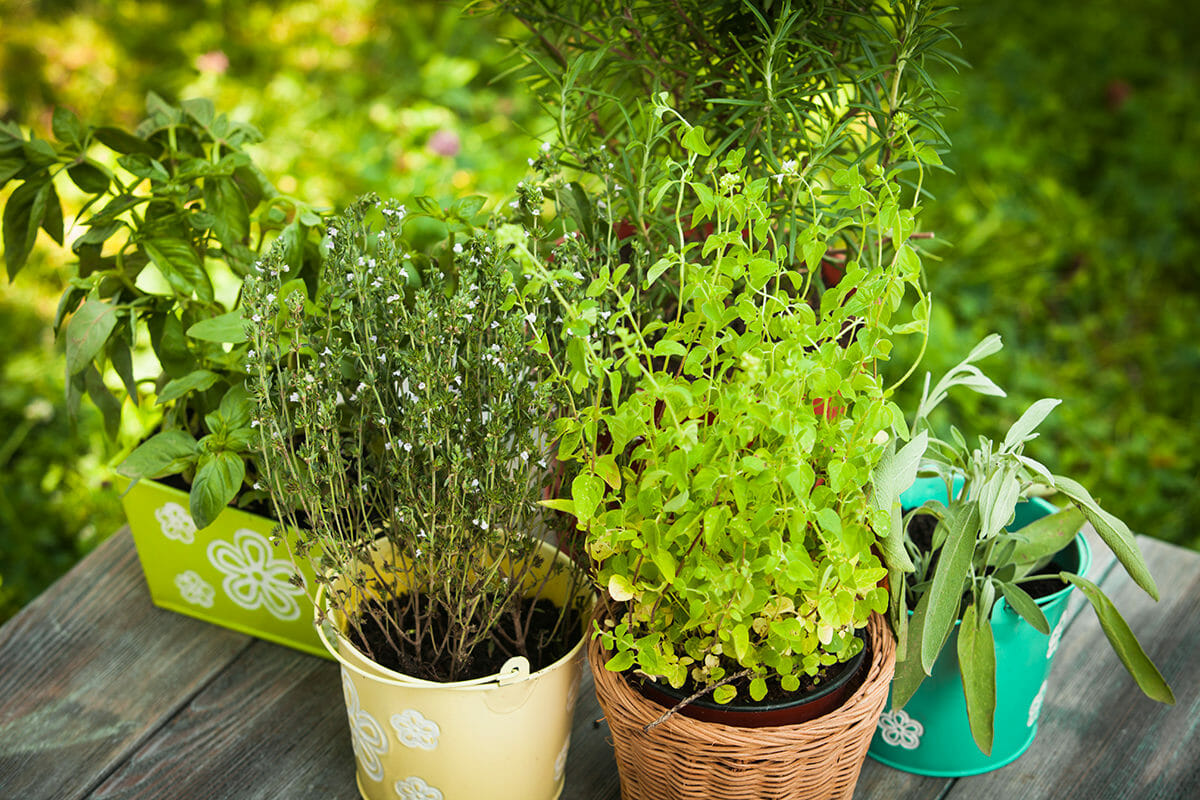There's no reason to buy half-wilted herbs in plastic packages for $3 a pop they're this easy to grow at home.

Annual herbs like basil and dill must be planted anew each year, but most other commonly used herbs qualify as perennials. They will go dormant where winters are cold, only to perk back up again each spring.
You have two options when it comes to starting perennial herbs: You can plant them directly in the ground or grow them in pots. Early spring is the best time to plant outdoors, but you can put the herbs in the ground any time of year that it’s not frozen. If going the potted route – a great option for those in colder regions looking to get started right away, or anyone who wants year-round harvests – make sure there’s a sunny window (or grow lights) available.
Harvest no more than 10% of the plant at a time if you want it stay alive and thriving.
The small stature of perennial herbs make them great candidates for windowsills, patios, balconies, and decks. All of the following varieties will thrive in two- to three-gallon containers. Instead of running to the store when you need a sprig of this or that, simply step out your back door. Just remember, you can only harvest a small portion of the plant at one time – ideally no more than 10 percent – if you want it stay alive and thriving.
[mf_h2 align=”left” transform=”uppercase”]Lavender[/mf_h2]
Uses: Flavoring for beverages and desserts; flowers may be used in dried arrangements, and herbal remedies, like tinctures
Growing Instructions: Plant in well-drained soil in a sunny location; cut off the flower stalks as they fade
Tip to Keep It Thriving: Lavender likes its soil on the dry side – be careful not to overwater
Bonus: Lavender blossoms are very attractive to butterflies
[mf_h2 align=”left” transform=”uppercase”]Sage[/mf_h2]
Uses: Meat, pasta sauces, and other savory dishes
Growing Instructions: Plant in well-drained soil in a sunny location
Tips to Keep It Thriving: Cut the stalks back by about 30 percent each fall to encourage lush new growth
Bonus: There are many varieties of sage besides the standard culinary herb – try pineapple sage for iced tea
[mf_h2 align=”left” transform=”uppercase”]Rosemary[/mf_h2]
Uses: An essential ingredient in many savory dishes; the woody stalks of the plant can be cut for use as flavor-enhancing shish kebab skewers
Growing Instructions: Plant in well-drained soil in a sunny location
Tips to Keep It Thriving: Rosemary likes its soil on the dry side – be careful not to overwater
Bonus: Try one of the low-growing, spreading rosemary varieties, such as ‘Prostratus’, for an aromatic groundcover
[mf_h2 align=”left” transform=”uppercase”]Mints[/mf_h2]
Uses: Flavoring for beverages and desserts
Growing Instructions: Plant in part shade and irrigate several times per week during hot, dry weather; tolerant of poorly drained soil
Tips to Keep It Thriving: As long as they have moisture, mints are hard to kill; more important is to know that you must plant them in pots if you don’t want them spreading all over the yard
Bonus: Lemon balm, a mint relative, provides a citrusy zest for your favorite iced beverage
[mf_h2 align=”left” transform=”uppercase”]Thyme[/mf_h2]
Uses: An essential ingredient in many savory dishes, especially those that hail from Italy
Growing Instructions: Plant in well-drained soil in a sunny location
Tips to Keep It Thriving: Cut the stalks back 50 percent in fall to encourage lush new growth
Bonus: This low-growing plant is an excellent groundcover for planting between steppingstones, where it will release its delicious fragrance each time you walk by
[mf_h2 align=”left” transform=”uppercase”]Oregano[/mf_h2]
Uses: An essential ingredient in many savory dishes, especially those that hail from Italy
Growing Instructions: Plant in well-drained soil in a sunny, or partly sunny, location
Tips to Keep It Thriving: Cut the stalks back 30 percent after they flower in summer
Bonus: Oregano has a drooping habit that is attractive in hanging baskets
[mf_h2 align=”left” transform=”uppercase”]Chives[/mf_h2]
Uses: Unparalleled in omelettes; use in any dish where you’d like to add a bit of onion flavor
Growing Instructions: Plant in a sunny location and irrigate at least once per week during hot, dry weather
Tips to Keep It Thriving: Chives grow from fleshy roots that can become overcrowded when confined in a pot – divide the roots into fist-size clumps and pot them up in fresh soil every two or three years
Bonus: The purple flowers also possess a light onion flavor – toss them in salads as a garnish
Looking to grow herbs.
I AM INTERESTED IN GROWING herbs in my yard.
Interested in receiving Modern Farmer newsletter.
I have a plastic green house. Is it too early to start herbs outside? I live in New Jersey. Thanks
I want to grow herbs.
I want to plant herbs, mints, onions, anything edible that will grow and multiply on its own in the front yard. One day I hope to have only edible plants, no grass in my yard, to share with the neighbors.
I want to grow a variety of herbs outside in my yard what grows well in a med sized box that smells nice and attracts butterflies like the monarch